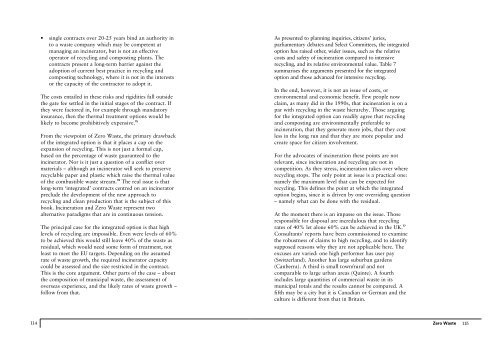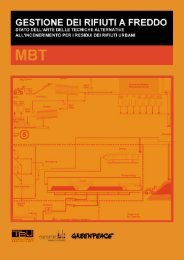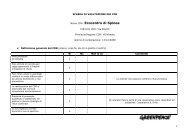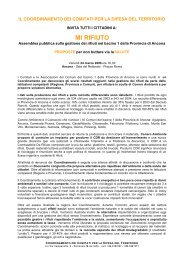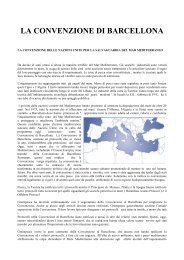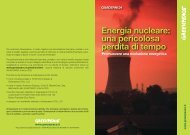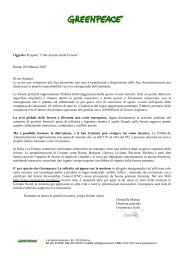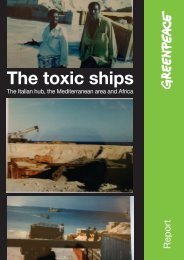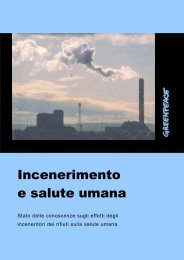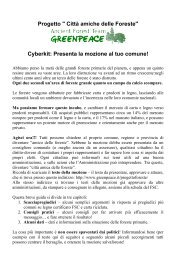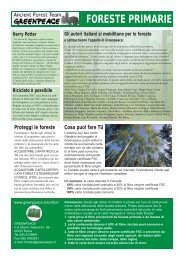Zero Waste by Robin Murray, Greenpeace Environmental Trust 2002
Zero Waste by Robin Murray, Greenpeace Environmental Trust 2002
Zero Waste by Robin Murray, Greenpeace Environmental Trust 2002
You also want an ePaper? Increase the reach of your titles
YUMPU automatically turns print PDFs into web optimized ePapers that Google loves.
• single contracts over 20-25 years bind an authority in<br />
to a waste company which may be competent at<br />
managing an incinerator, but is not an effective<br />
operator of recycling and composting plants. The<br />
contracts present a long-term barrier against the<br />
adoption of current best practice in recycling and<br />
composting technology, where it is not in the interests<br />
or the capacity of the contractor to adopt it.<br />
The costs entailed in these risks and rigidities fall outside<br />
the gate fee settled in the initial stages of the contract. If<br />
they were factored in, for example through mandatory<br />
insurance, then the thermal treatment options would be<br />
likely to become prohibitively expensive. 75<br />
From the viewpoint of <strong>Zero</strong> <strong>Waste</strong>, the primary drawback<br />
of the integrated option is that it places a cap on the<br />
expansion of recycling. This is not just a formal cap,<br />
based on the percentage of waste guaranteed to the<br />
incinerator. Nor is it just a question of a conflict over<br />
materials – although an incinerator will seek to preserve<br />
recyclable paper and plastic which raise the thermal value<br />
of the combustible waste stream. 76 The real issue is that<br />
long-term ‘integrated’ contracts centred on an incinerator<br />
preclude the development of the new approach to<br />
recycling and clean production that is the subject of this<br />
book. Incineration and <strong>Zero</strong> <strong>Waste</strong> represent two<br />
alternative paradigms that are in continuous tension.<br />
The principal case for the integrated option is that high<br />
levels of recycling are impossible. Even were levels of 60%<br />
to be achieved this would still leave 40% of the waste as<br />
residual, which would need some form of treatment, not<br />
least to meet the EU targets. Depending on the assumed<br />
rate of waste growth, the required incinerator capacity<br />
could be assessed and the size restricted in the contract.<br />
This is the core argument. Other parts of the case – about<br />
the composition of municipal waste, the assessment of<br />
overseas experience, and the likely rates of waste growth –<br />
follow from that.<br />
As presented to planning inquiries, citizens’ juries,<br />
p a r l i a m e n t a ry debates and Select Committees, the integrated<br />
option has raised other, wider issues, such as the re l a t i v e<br />
costs and safety of incineration compared to intensive<br />
recycling, and its relative environmental value. Table 7<br />
summarises the arguments presented for the integrated<br />
option and those advanced for intensive recycling.<br />
In the end, however, it is not an issue of costs, or<br />
environmental and economic benefit. Few people now<br />
claim, as many did in the 1990s, that incineration is on a<br />
par with recycling in the waste hierarchy. Those arguing<br />
for the integrated option can readily agree that recycling<br />
and composting are environmentally preferable to<br />
incineration, that they generate more jobs, that they cost<br />
less in the long run and that they are more popular and<br />
create space for citizen involvement.<br />
For the advocates of incineration these points are not<br />
relevant, since incineration and recycling are not in<br />
competition. As they stress, incineration takes over where<br />
recycling stops. The only point at issue is a practical one:<br />
namely the maximum level that can be expected for<br />
recycling. This defines the point at which the integrated<br />
option begins, since it is driven <strong>by</strong> one overriding question<br />
– namely what can be done with the residual.<br />
At the moment there is an impasse on the issue. Those<br />
responsible for disposal are incredulous that recycling<br />
rates of 40% let alone 60% can be achieved in the UK. 77<br />
Consultants’ reports have been commissioned to examine<br />
the robustness of claims to high recycling, and to identify<br />
supposed reasons why they are not applicable here. The<br />
excuses are varied: one high performer has user pay<br />
(Switzerland). Another has large suburban gardens<br />
(Canberra). A third is small town/rural and not<br />
comparable to large urban areas (Quinte). A fourth<br />
includes large quantities of commercial waste in its<br />
municipal totals and the results cannot be compared. A<br />
fifth may be a city but it is Canadian or German and the<br />
culture is different from that in Britain.<br />
114<br />
<strong>Zero</strong> <strong>Waste</strong><br />
115


